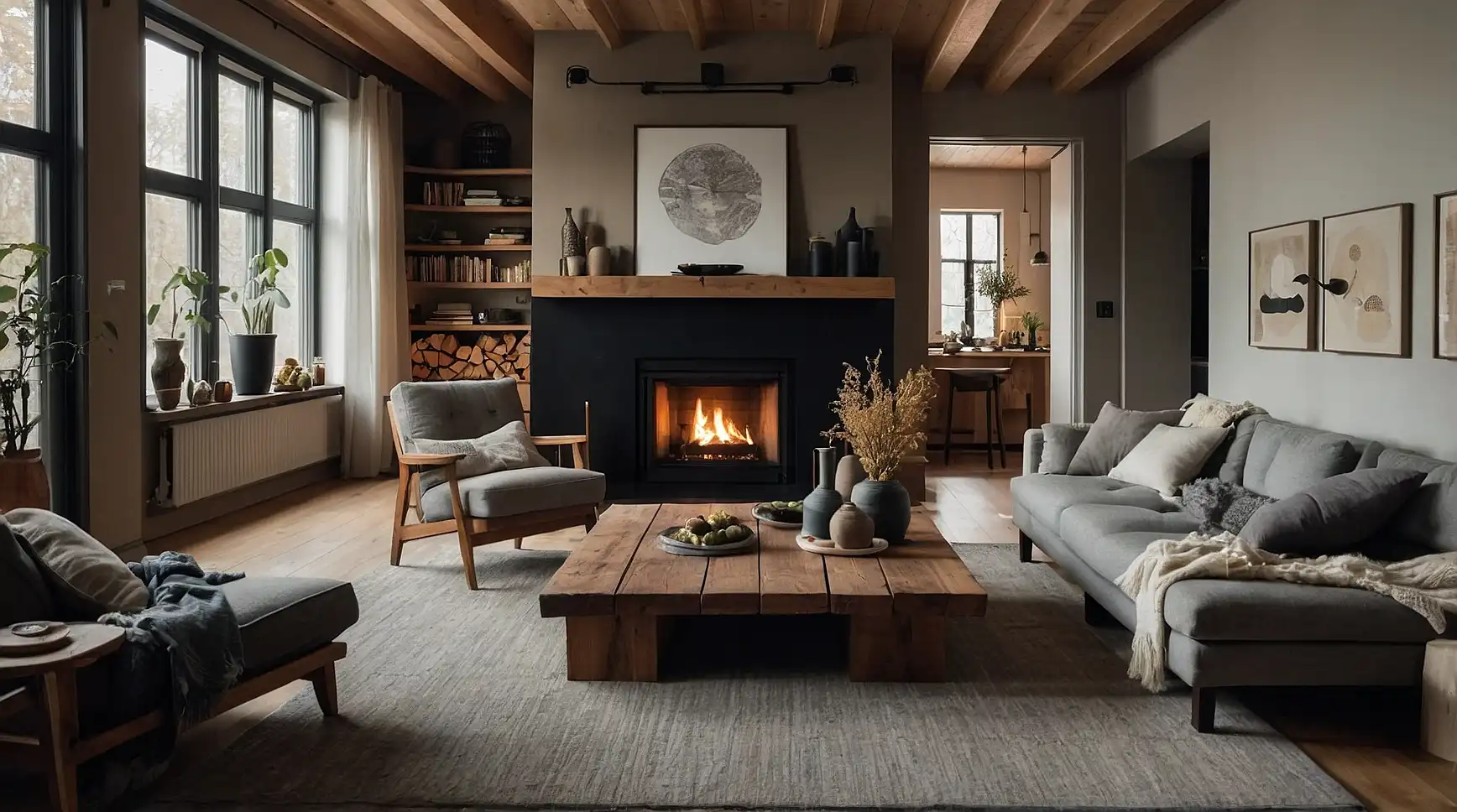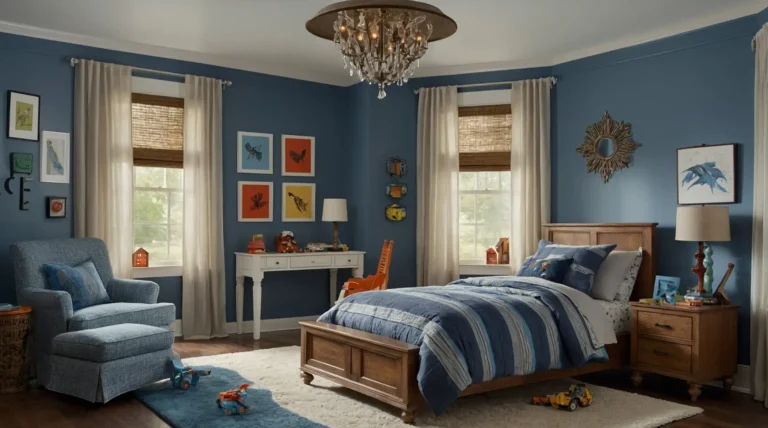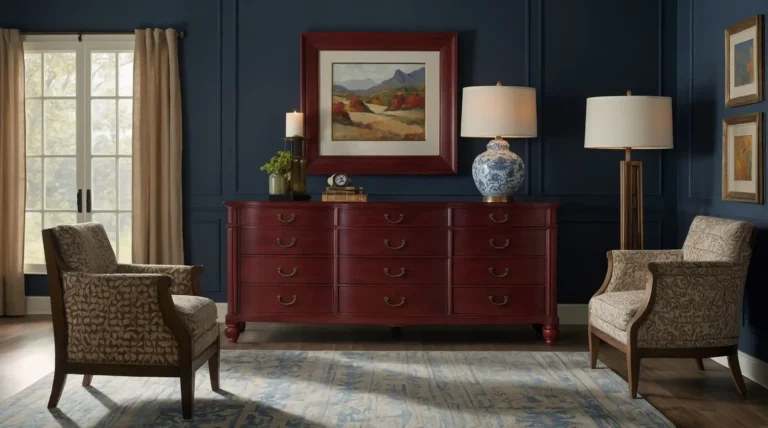27 Simple Hygge Living Room Ideas That Transform Ordinary Spaces Into Cozy Sanctuaries
Creating a hygge-inspired living room allows you to embrace the Danish concept of coziness and contentment in your everyday space.
This Scandinavian approach celebrates warmth, comfort, and simple pleasures that make your home feel like a sanctuary.
You don’t need a complete renovation to achieve this peaceful aesthetic.
Simple additions and thoughtful adjustments can transform your living room into a hygge haven regardless of your current decor style.
Ready to create your own cozy retreat?
These 27 hygge living room ideas will help you incorporate this lifestyle philosophy into your home, creating a space where you naturally want to slow down and savor the moment.
1: Layer Soft, Natural Textiles

Add multiple throws in different textures—chunky knits, soft fleece, and woven cotton—to create inviting depth.
Mix in various cushions of different sizes and materials for irresistible comfort.
Natural fibers like wool, cotton, and linen add authentic hygge texture while remaining breathable.
These layers invite you to sink in, get comfortable, and stay awhile—the essence of hygge living.
2: Create a Reading Nook

Designate a comfortable corner with a plush armchair, soft lighting, and a small side table. Position it near a window for natural light or in a quiet corner away from household traffic.
Add a soft throw, a small bookshelf, and a footstool to create a dedicated space for slow moments with a good book.
This intentional spot encourages the hygge practice of finding joy in quiet leisure.
3: Incorporate Warm Woods

Introduce wooden elements through furniture, picture frames, or decorative objects.
Look for pieces with natural grain patterns and warm, honey-toned finishes rather than dark or heavily lacquered woods.
Natural wood brings the outdoors in and creates an instant feeling of groundedness and warmth.
The organic textures and grain patterns add visual interest while maintaining the simplicity central to hygge design.
4: Display Candles in Groups

Arrange candles of varying heights in clusters throughout your living room. Choose unscented or gently scented options in neutral colors that complement your existing decor.
The Danes burn more candles per person than anywhere else in Europe, considering candlelight essential to hygge.
The soft, flickering glow creates an atmosphere that electric lighting simply cannot replicate.
5: Create Conversation Areas

Arrange seating to face each other rather than the television.
Position sofas and chairs at comfortable distances for easy conversation—close enough to feel intimate but not crowded.
Add a soft rug underneath to define and anchor the space.
This thoughtful arrangement encourages meaningful connection with family and friends—a central element of the hygge philosophy.
6: Integrate Natural Elements

Add houseplants, branches, or dried flowers to bring nature indoors.
Choose low-maintenance varieties like succulents or peace lilies if you don’t have a green thumb.
Display interesting stones, pieces of driftwood, or seasonal elements like pinecones.
These natural objects create a subtle connection to the outdoors even when weather keeps you inside.
7: Simplify Your Color Palette

Embrace a neutral color scheme with whites, creams, grays, and soft browns. This creates a calm foundation that allows textures to become the focal point of your space.
Add subtle color through natural elements and textiles rather than bold paint or patterns.
This restrained approach creates visual harmony that helps your mind relax when entering the room.
8: Install Adjustable Lighting

Create layers of light with floor lamps, table lamps, and candles rather than relying on harsh overhead lighting.
Use warm-toned bulbs (2700-3000K) to create a golden, flattering glow.
Add dimmer switches to control brightness levels throughout the day and evening.
The ability to adjust lighting to match your mood and activity embodies the intentional comfort of hygge living.
9: Display Meaningful Photos

Curate small collections of cherished photos in simple frames. Choose images that evoke positive memories and genuine happiness rather than formal portraits.
Position these personal treasures where you’ll naturally see them during daily activities.
These visual reminders of loved ones and happy times reinforce the hygge value of gratitude and connection.
10: Add a Soft Area Rug

Choose a plush, natural fiber rug in a neutral tone to anchor your seating area. The soft texture feels wonderful underfoot and adds literal warmth to wood or tile floors.
Layer smaller rugs over larger ones for added texture and coziness.
This simple addition makes your living room feel instantly more inviting and comfortable during cold weather months.
11: Create a Technology-Free Zone

Designate part of your living room as a screen-free area with books, games, and comfortable seating.
This intentional space encourages unplugged activities and mindful relaxation.
Store remotes and devices in closed containers when not in use.
Reducing visual technology clutter helps create a more peaceful environment that encourages presence and connection.
12: Display Books Thoughtfully

Arrange books in small, accessible stacks on coffee tables or side tables. Choose titles with beautiful covers that invite casual browsing and spontaneous reading sessions.
Create a mini library with open shelving for favorite volumes.
Books not only provide entertainment perfectly aligned with hygge values but also add color and personality to your space.
13: Incorporate Handmade Items

Display ceramics, textiles, or artwork created by local artisans or loved ones. These unique pieces add authentic character and story to your space that mass-produced items cannot match.
Create your own simple crafts like macramé plant hangers or hand-knitted throws. The hygge philosophy celebrates the process of creating as much as the finished product.
14: Add a Fireplace or Alternative

If possible, make a wood-burning fireplace the focal point of your living room. The crackling sound, dancing flames, and subtle scent create the ultimate hygge atmosphere.
No fireplace? Create alternatives with candle groupings, a bioethanol fireplace, or even a carefully curated video of a fire on a screen.
The warm glow creates a natural gathering point.
15: Choose Round, Soft Furniture

Select sofas and chairs with rounded edges and plush upholstery rather than angular, firm pieces. These softer shapes create a more welcoming, relaxed visual and physical experience.
Add an ottoman that can serve as a coffee table, footrest, or extra seating.
Multifunctional, comfortable pieces embody the practical coziness central to hygge philosophy.
16: Create Window Nooks

Transform window areas into cozy seating spaces with bench cushions, pillows, and throws.
These light-filled spots become natural retreats for daydreaming, reading, or simply watching the world outside.
Add sheer curtains that diffuse light without blocking it completely.
These soft barriers create a sense of gentle separation from the outside world while maintaining connection to nature.
17: Display Vintage Objects

Incorporate items with history and patina—old wooden bowls, well-worn leather books, or antique picture frames.
These pieces bring depth and character to your space that new items cannot replicate.
Choose objects that tell a story or hold personal meaning rather than random antiques.
The hygge philosophy values objects that connect us to history, family, and genuine experiences.
18: Add Subtle, Natural Scents

Introduce gentle aromas through natural elements like eucalyptus branches, cinnamon sticks, or dried lavender.
These subtle scents create an immersive sensory experience without overwhelming the space.
Use essential oil diffusers with cozy scents like vanilla, cedar, or cardamom.
Fragrance forms powerful connections to memory and emotion, enhancing the hygge atmosphere on a subconscious level.
19: Create Seasonal Displays

Rotate simple displays of natural elements to reflect the changing seasons—spring blossoms, summer shells, autumn leaves, winter evergreens.
These mindful changes connect your home to nature’s rhythm.
Keep these arrangements simple and authentic rather than formal or contrived.
This practice encourages awareness of seasonal shifts and appreciation for each period’s unique beauty.
20: Install Soft Window Treatments

Hang natural fabric curtains that filter light gently throughout the day. Choose materials like linen or cotton in neutral tones that blend with your overall color scheme.
Add thermal linings to create a sense of protection and insulation during cold weather.
This barrier between your cozy interior and the outside elements enhances the sanctuary feeling of your space.
21: Incorporate Woven Baskets

Use natural fiber baskets to store everyday items like throws, magazines, or children’s toys.
These practical containers add texture while helping maintain the clutter-free simplicity essential to hygge.
Choose handwoven pieces in natural materials like seagrass, rattan, or water hyacinth.
These organic elements add warmth and interest while serving an essential organizing function.
22: Create Tea or Coffee Stations

Arrange a small tray with beautiful mugs, a teapot, and your favorite beverages within easy reach of your seating area.
This thoughtful setup encourages regular moments of calm refreshment.
Include special touches like a honey dipper, cinnamon sticks, or a favorite tin of cookies. These small luxuries transform ordinary drinks into mindful rituals central to hygge living.
23: Add Soft, Warm Lighting Fixtures

Choose lampshades that diffuse light softly rather than directing it harshly. Fabric or paper shades in warm tones create the gentle illumination essential to hygge atmosphere.
Install fairy lights in glass jars or along bookshelves for magical ambient lighting.
These twinkling elements create a sense of wonder and coziness, especially during darker winter months.
24: Display Meaningful Collections

Arrange small collections of meaningful items—seashells from family vacations, inherited teacups, or handmade pottery.
Group similar objects together for visual cohesion rather than scattered placement.
Keep these displays intentionally curated rather than cluttered. The hygge philosophy values quality over quantity and meaningful objects over random accumulation.
25: Create Contrast with Texture

Balance smooth surfaces like leather or glass with nubby textiles and rough natural elements.
This thoughtful contrast creates visual and tactile interest without requiring bold colors or patterns.
Mix materials like wood, wool, ceramic, and metal in similar color tones.
This textural variety creates depth and richness while maintaining the calm simplicity essential to hygge design.
26: Add Floor Pillows and Poufs

Incorporate large floor cushions that can be moved easily for flexible, casual seating. These versatile pieces invite more relaxed postures and informal gathering.
Choose washable covers in natural fabrics for practicality and comfort.
These additional seating options allow your living room to accommodate impromptu gatherings without feeling crowded or formal.
27: Create Intimate Spaces Within Larger Rooms

Use furniture arrangement, rugs, or screens to create smaller “rooms” within your living area. These defined spaces create feelings of intimacy and enclosure essential to the hygge experience.
Position seating to create a slight sense of enclosure rather than exposure.
This thoughtful arrangement helps people feel protected and secure—the foundation of true relaxation.
Conclusion
Your hygge living room doesn’t require expensive renovations or perfect styling—just thoughtful elements that encourage comfort, presence, and genuine contentment.
Start with what speaks to you and gradually create your own cozy sanctuary.








Wow, wonderful blog layout! How long have you been blogging for? you made blogging look easy. The overall look of your website is fantastic, let alone the content!